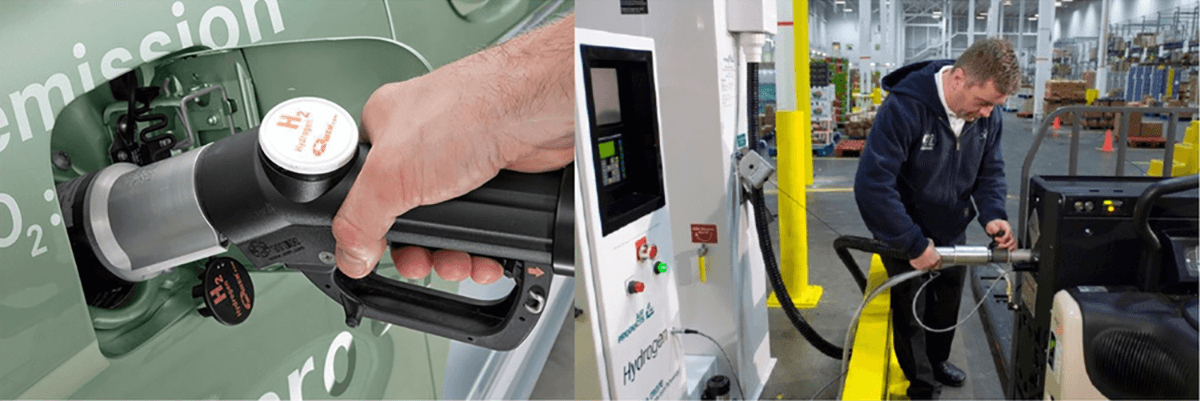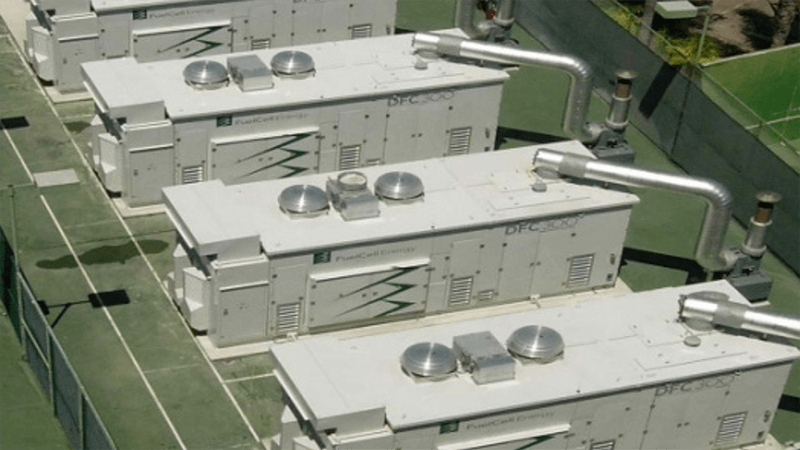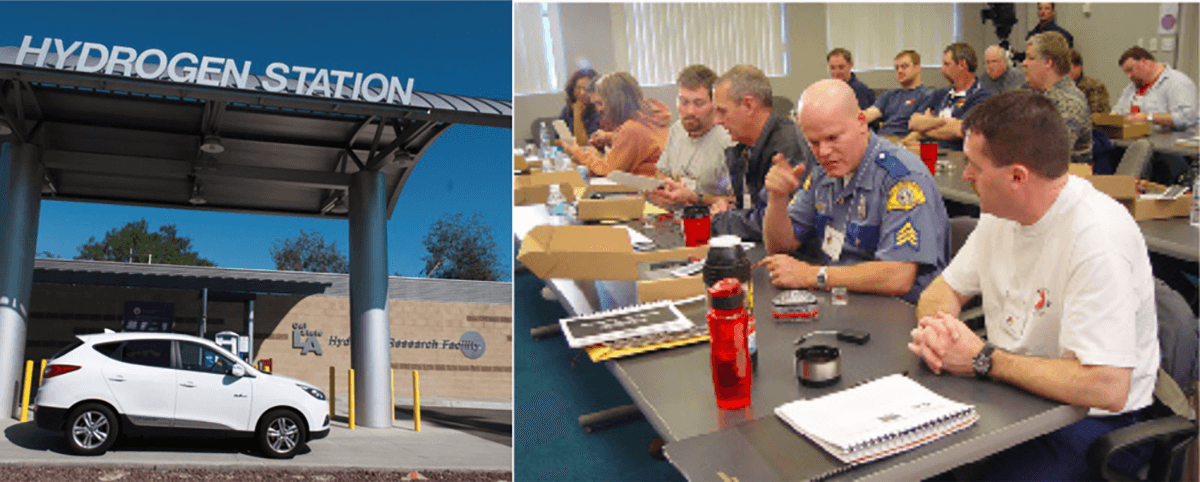Safety, Codes and Standards

Hydrogen and fuel cell technologies are poised to play an integral role in our energy future. Hydrogen, a versatile fuel with a history of safe use in industrial applications for many decades. It can be produced using diverse domestic resources, including wind, solar, hydroelectric, nuclear, natural gas, and coal with carbon sequestration. Fuel cells provide a highly efficient means for producing electricity from hydrogen. They can be built to a variety of scales to provide power for distributed power systems, utility-scale generation, specialty vehicles (e.g., forklifts and airport baggage tugs), automobiles, buses, auxiliary power applications, and portable electronic equipment.
Hydrogen Safety Facts
Hydrogen has unique physical and chemical properties which present benefits and challenges to its successful widespread adoption as a fuel. Hydrogen is the lightest, smallest, and most abundant element in the universe. Hydrogen is 14 times lighter than air and rises at a speed of almost 20 meters per second (6 times faster than natural gas), which means that it rises and disperses quickly when released. Hydrogen is also odorless, colorless, and tasteless, making it undetectable by human senses. For these reasons, hydrogen systems are designed with ventilation and leak detection. Natural gas is also odorless, colorless, and tasteless, but a sulfur- containing odorant is added so people can detect it. There is no known odorant light enough to “travel with” hydrogen at an equal dispersion rate, so odorants are not used to provide a detection method. Many odorants can also contaminate fuel cells.
Under optimal combustion conditions, the energy required to initiate hydrogen combustion is significantly lower than that required for combustion of other common fuels, such as natural gas or gasoline. The energy required to initiate combustion of low concentrations of hydrogen in the air is similar to that of other fuels. Combustion cannot occur in a hydrogen vessel or any contained location that contains only hydrogen – an oxidizer, such as oxygen, is required. Hydrogen flames have low radiant heat. A hydrogen fire has significantly less radiant heat than a hydrocarbon fire (a fire fueled by hydrocarbon products such as petroleum and natural gas). Although a hydrogen flame is just as hot as a hydrocarbon flame, the levels of heat emitted from the flame are lower. This decreases the risk of secondary fires.
Hydrogen is unlikely to cause asphyxiation. With the exception of oxygen, any gas can cause asphyxiation in high enough concentrations. Because hydrogen rises and disperses so rapidly, it is unlikely to cause asphyxiation. Hydrogen is non-toxic and non-poisonous. It is a gas under normal atmospheric conditions, and a release of hydrogen does not contribute to atmospheric or water pollution. Hydrogen can be used as safely as other common fuels we use today when guidelines are observed and users understand its behavior.
A Record of Safety
The hydrogen and fuel cell industry has seen a ~30% annual growth rate in fuel cell shipments since 2010 and industry revenues have surpassed the $2B mark. With more than 60,000 fuel cells shipped worldwide in 2015, this is a very exciting time for the fuel cell industry.
To ensure the safe use of these technologies, industry considers the unique properties of hydrogen when determining how it will be used and stored. Components are built to meet strict manufacturer and published guidelines and undergo third-party testing for safety and structural integrity.
As the technology develops and the number of installations increases, education and training becomes even more critical. Emergency personnel must be prepared to handle potential incidents, and public education must be provided to familiarize users with simple hydrogen safety practices.

Hydrogen Tools Portal (www.h2tools.com)
The Hydrogen Tools Portal, located at www.h2tools.com, brings together and enhances the utility of a variety of tools and web-based content on the safety aspects of hydrogen and fuel cell technologies. It is intended to help inform those tasked with designing, approving, or using systems and facilities, as well as those responding to incidents. In addition, more than 36,000 first responders and code officials have been reached through online and in- person trainings. More resources and tools will be added in the future and feedback on how to improve the site is welcome—please send comments or suggestions for additional content.
Safety Research
The U.S. Department of Energy (DOE) Fuel Cell Technologies Safety, Codes & Standards program supports research and development (R&D) that provides critical data and information needed to define requirements for the development of technically sound codes and standards to enable the widespread commercialization and safe deployment of hydrogen and fuel cell technologies. Researchers in government, industry, and academia are working to further analyze critical hydrogen behavior data; develop reliable, inexpensive hydrogen sensor and leak detection technologies; and identify tools and methodologies to support the development of hydrogen codes and standards, including the development of the Hydrogen Risk Assessment Models (HyRAM) software tool, available for download at https://hyram.sandia.gov.
The hydrogen safety information resources and best practices are being developed, based on safety R&D as well as external stakeholder input from the fire-protection community, academia, automobile manufacturers, and the energy, insurance, and aerospace sectors. The resources create and enhance safety knowledge tools for emergency responders and authorities having jurisdiction. Examples of these resources are listed in the Codes and Standards Information Resources box below. DOE develops safety knowledge tools in order to reach the largest number of safety personnel possible and to ensure continued safe use of hydrogen.

Codes and Standards
Hydrogen codes and standards are being developed to provide the information needed to safely build, maintain, and operate hydrogen and fuel cell systems. Federal and state agencies are working to ensure uniformity of safety requirements and to provide local officials and safety inspectors with the information needed to certify these technologies. DOE promotes collaboration among government, industry, standards development organizations, universities, and national laboratories in an effort to harmonize regulations, codes, and standards both internationally and domestically. This work is critical to global competitiveness and the successful early market introduction of hydrogen and fuel cell technologies.
For More Information
More information on the Fuel Cell Technologies Office is available at http:// www.hydrogenandfuelcells.energy.gov
ACodes and Standards Information Resources (http://hydrogen.energy.gov/codes_standards.html)
Permitting Hydrogen Facilities http://www.hydrogen.energy.gov/permitting/
Introduction to Hydrogen for Code Officials http://www.hydrogen.energy.gov/training/code_official_training/
Introduction to Hydrogen Safety for First Respondershttps://www.hydrogen.energy.gov/firstresponders.html